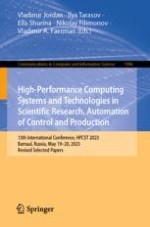2024 | Buch
High-Performance Computing Systems and Technologies in Scientific Research, Automation of Control and Production
13th International Conference, HPCST 2023, Barnaul, Russia, May 19–20, 2023, Revised Selected Papers
herausgegeben von: Vladimir Jordan, Ilya Tarasov, Ella Shurina, Nikolay Filimonov, Vladimir A. Faerman
Verlag: Springer Nature Switzerland
Buchreihe : Communications in Computer and Information Science
